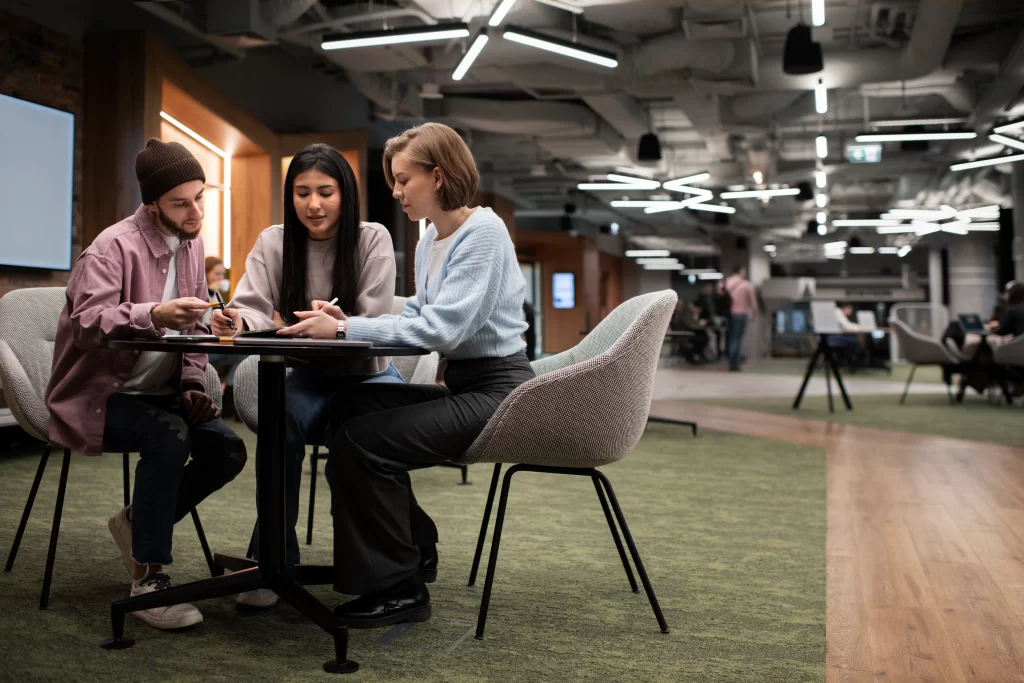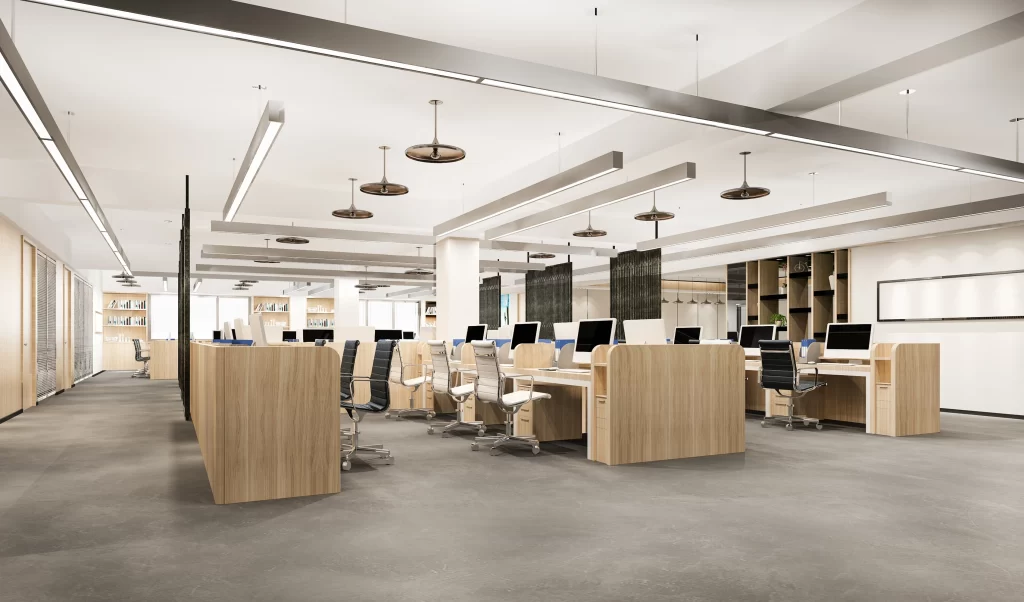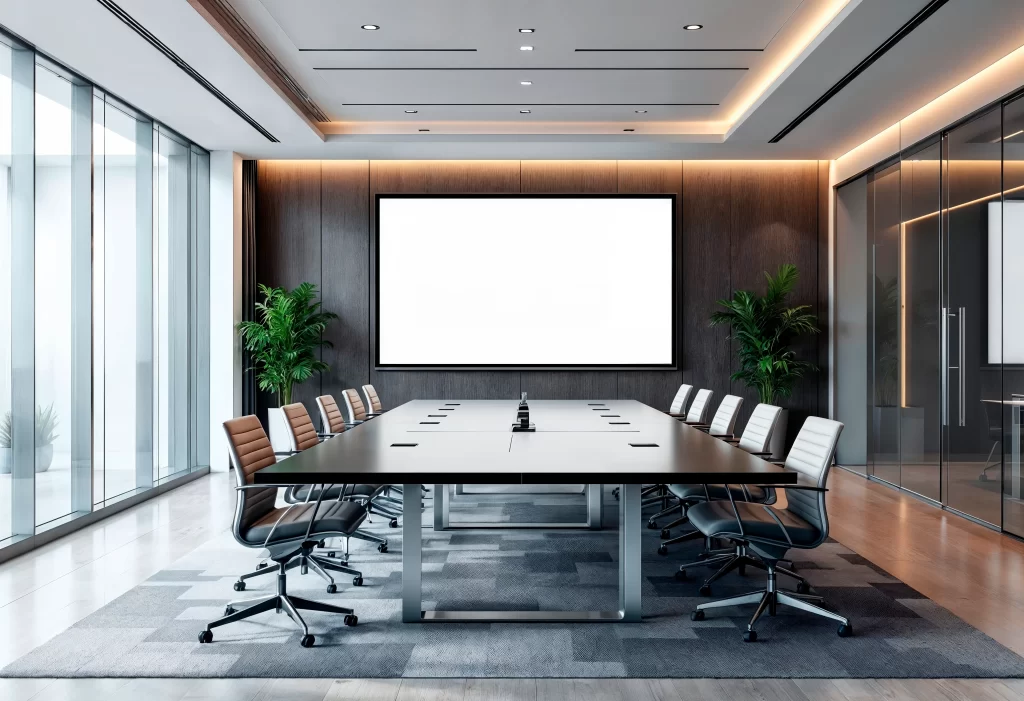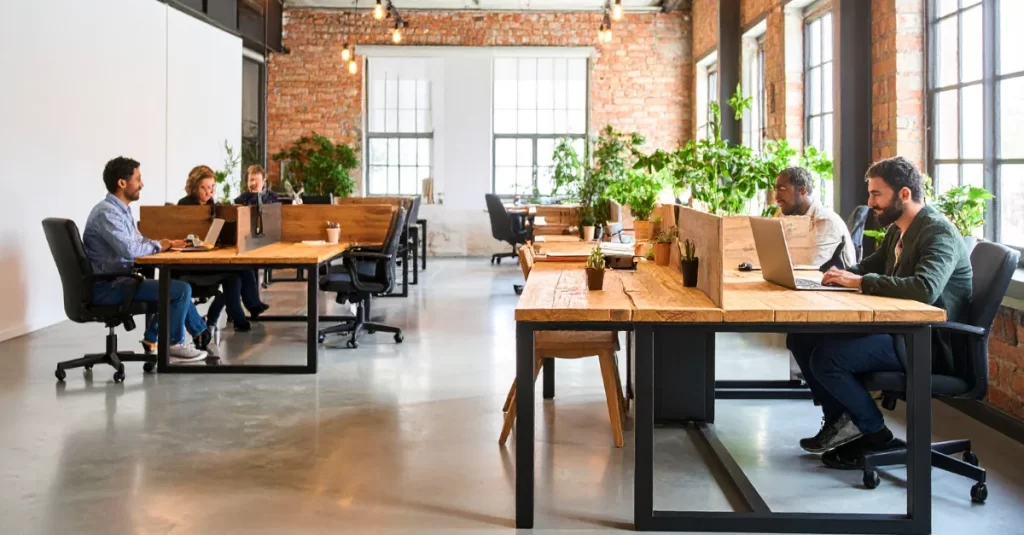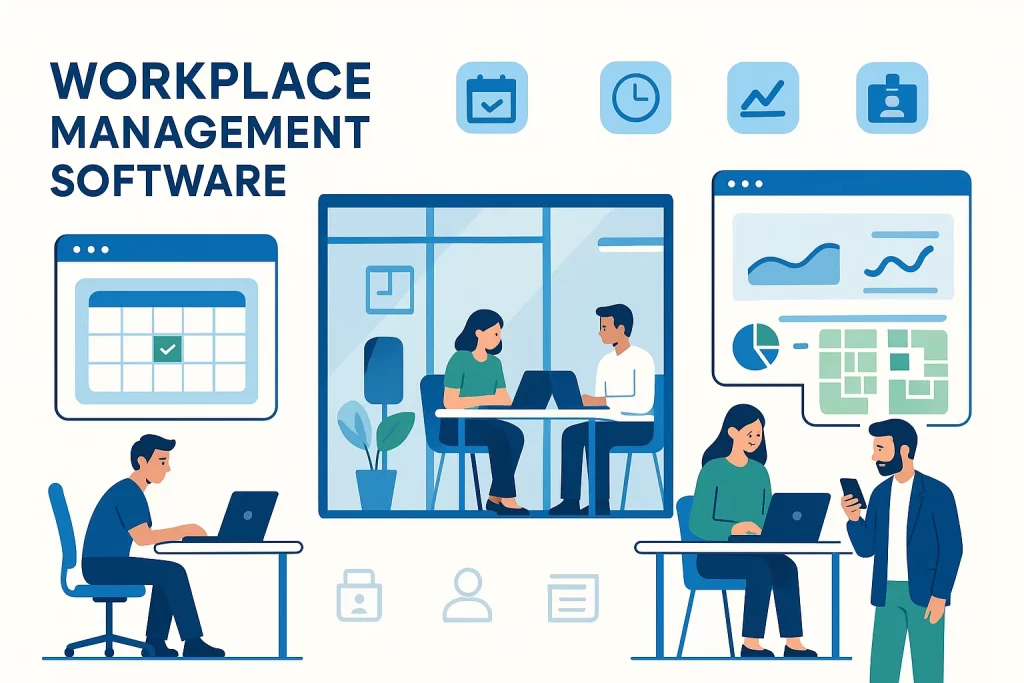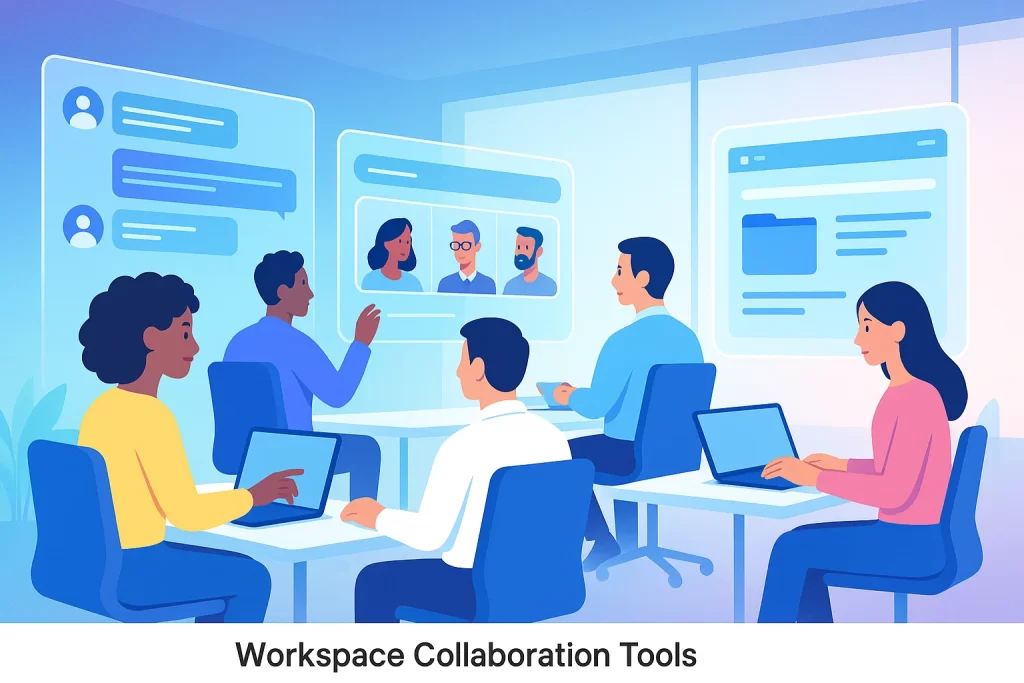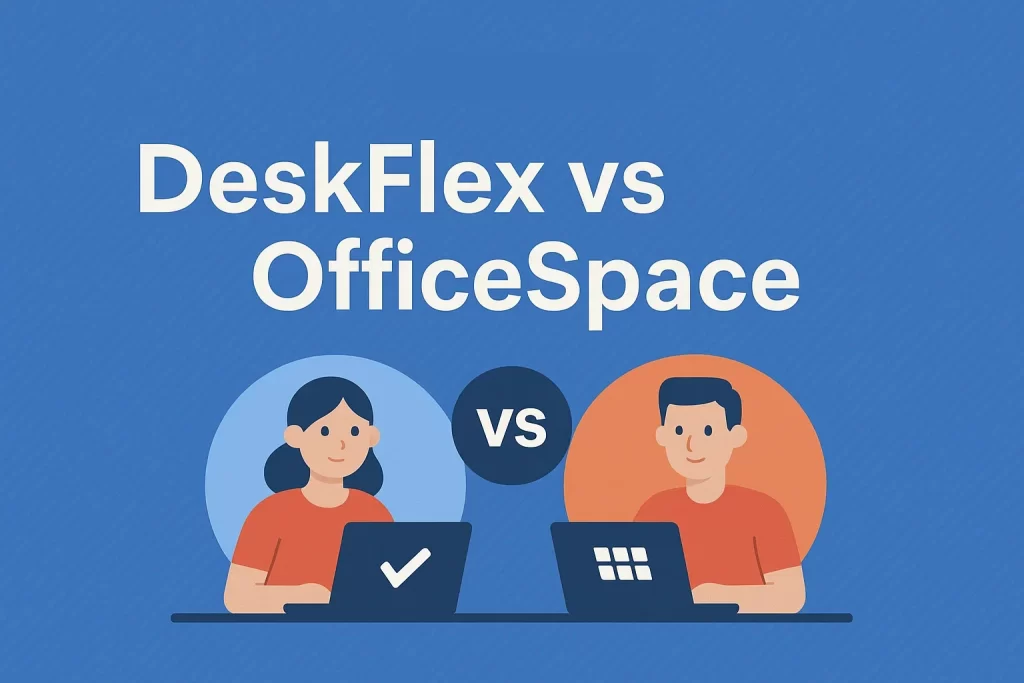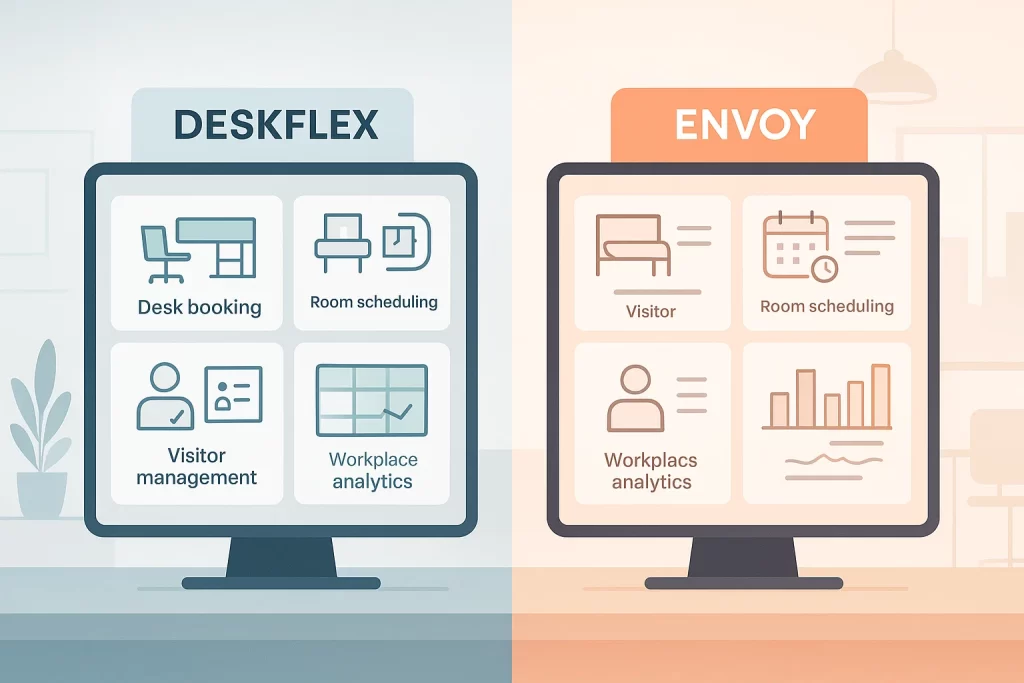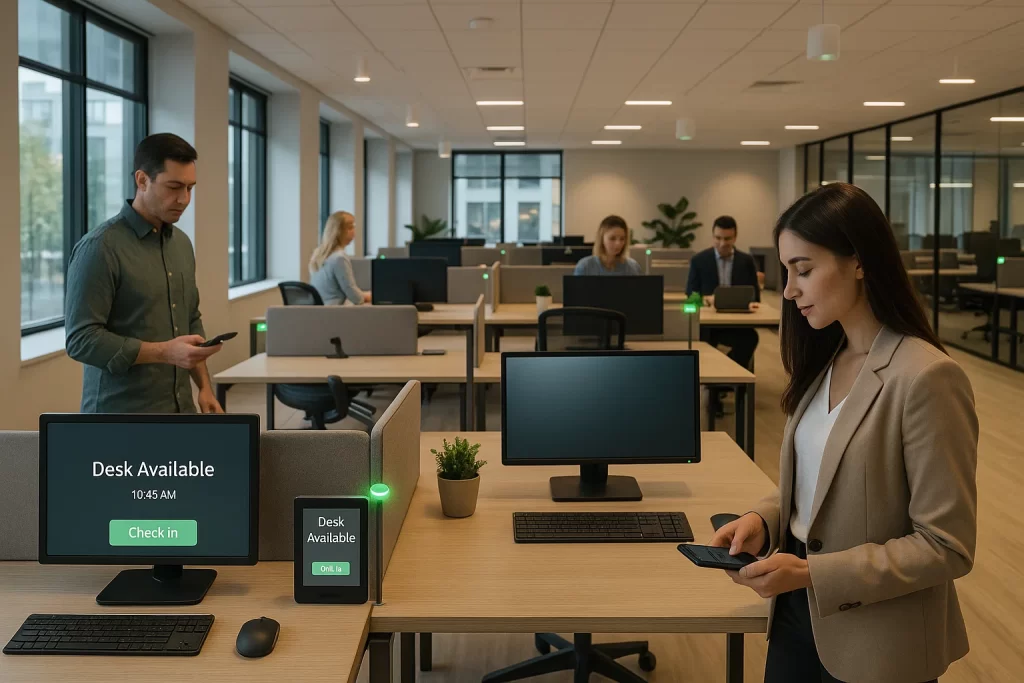
Office Layout and Its Impact on Workplace Productivity 2025
Office layouts shape the physical arrangement of workspaces within a company, influencing how employees interact, collaborate, and carry out tasks.
Choosing the right layout has a major impact on everything from employee morale to operational efficiency.
A well-planned layout not only supports focus but also encourages teamwork, making it essential for boosting overall productivity and satisfaction.
Thoughtfully organized spaces reduce distractions,enhance workspace efficiency, and help create a comfortable and motivating environment for employees.
By carefully selecting a layout suited to their needs, companies can promote a healthier work environment and better align their space with employee satisfaction and performance.
In this article, we will explore various office layouts, their benefits, and how to select the best fit for different work environments.
What Are the Different Types of Office Layouts?
Office layouts play a crucial role in shaping the work environment, as they influence everything from productivity to employee well-being.
With various layout options available, organizations can tailor their space to best fit their teams’ needs, work styles, and goals.
1. Traditional Office Layout
A traditional office layout is designed with individual offices and separate rooms for different departments, providing a structured, hierarchical setup.
This layout often features private offices for senior staff, conference rooms, and dedicated spaces for each department, which helps maintain a clear division of roles within the organization.
- Benefits: Offers privacy and a quiet, focused environment with fewer distractions, ideal for employees requiring a high degree of concentration.
- Drawbacks: Limits spontaneous collaboration and may result in unused or wasted space due to dedicated offices.
- Best suited for: Organizations that prioritize privacy and hierarchy, such as law firms and financial services companies, where individual work often requires minimal interruption.
2. Open Plan Office Layout
An open office layout is characterized by large, open spaces with minimal walls and shared or communal desks.
This design fosters an inclusive environment, allowing for frequent interaction among employees and encouraging an open flow of ideas.
- Benefits: Facilitates easy communication and teamwork while making efficient use of floor space. The layout is often more cost-effective as it reduces the need for many physical barriers or walls.
- Drawbacks: Higher noise levels and potential distractions are common in open layouts, making it challenging for some employees to focus. Privacy is limited, which may impact tasks that require concentration.
- Best suited for: Startups, creative industries, and companies that rely heavily on collaboration and brainstorming.
3. Hybrid Office Layout
The hybrid office layout blends elements from various layouts, including open spaces, cubicles, and private rooms.
This flexible approach caters to diverse work styles and can be adjusted to meet changing needs, making it a popular choice for modern workplaces.
- Benefits: Provides flexibility and adaptability, accommodating both collaboration and focused work in a single environment.
- Drawbacks: Needs thoughtful planning to ensure a consistent workflow and may create logistical challenges.
- Best suited for: Companies that support a hybrid work model, where employees may need both shared spaces for meetings and private areas for focused tasks.
4. Cubicle Office Layout
Cubicle layouts feature partitioned workstations that provide semi-private spaces for employees.
These layouts strike a balance between open and closed office designs, offering individualized workspaces while still keeping employees within sight.
- Benefits: Provides a personal workspace with some level of sound reduction, allowing employees to focus better than in an open layout.
- Drawbacks: Cubicles can feel isolating, and the partitions may block natural light, impacting overall ambiance.
- Best suited for: Work that requires moderate interaction between employees but also demands concentrated focus, such as in call centers and administrative roles.
5. Co-working Office Layout
The co-working layout is popular in shared office environments, where freelancers, startups, and remote workers gather in flexible, communal spaces.
Co-working layouts provide flexible seating and encourage collaboration through shared spaces and communal areas.
- Benefits: Promotes networking, collaboration, and flexibility, making it ideal for workers who thrive in a dynamic environment.
- Drawbacks: Lack of privacy and limited personal desk ownership may pose challenges for some workers.
- Best suited for: Freelancers, startups, and remote workers who benefit from a social environment and have flexible schedules.
6. Team-Based Office Layout
Team-based layouts organize the office into zones for each team or department, with group desks and dedicated meeting areas.
This layout is designed to support team-oriented tasks and enhances focus within task-specific zones.
- Benefits: Encourages collaboration within teams and improves efficiency by placing team members close to each other.
- Drawbacks: Typically requires more floor space, which may not be ideal for small offices.
- Best suited for: Companies with clearly defined teams working on collaborative projects, such as project-based industries and tech development teams.
Key Elements of an Office Design for Productivity and Comfort
Creating a productive and comfortable office goes beyond desk arrangements and meeting rooms. Each element in office design—from floor plans to lighting—contributes to employee well-being and overall work efficiency.
A well-thought-out office layout can make the space adaptable to different tasks and work styles while supporting diverse teams.
Let’s break down the core elements that make up a successful office design.
Office Floor Plan Design and Layout
The foundation of any effective office layout lies in its office floor plans. It’s not just a place where work happens; a strategic floor plan optimizes space utilization by balancing open areas for collaboration with quiet zones for focused work.
Essential components include common pathways to streamline movement, communal spaces for social interaction, and maximizing access to natural light.
By considering each of these, businesses can create a dynamic environment that accommodates various work needs.
Ergonomic and Comfortable Office Furniture
Adjustable workstations, supportive chairs, and spacious desks allow employees to work comfortably, reducing physical strain and fatigue.
Properly chosen furniture not only enhances productivity but also boosts employee morale by showing commitment to their well-being.
Lighting and Its Impact on the Work Environment
Lighting plays a big role in workplace ambiance. Adequate lighting, particularly natural light, is especially beneficial, positively affecting employee mood, focus, and productivity.
For small offices or spaces with limited window access, using desk lamps, overhead lighting, and strategically placed windows can enhance brightness and minimize eye strain, creating a more inviting workspace.
Incorporating Natural Elements and Aesthetics
Adding natural elements like plants, water features, and calming color schemes can lower stress and create a more balanced atmosphere.
When combined with functional layouts, these elements foster a welcoming and aesthetically pleasing environment.
Incorporating current office decor trends can help refresh the workspace, making it more enjoyable for employees.
Noise Reduction Techniques and Quiet Zones
Incorporating sound-absorbing elements such as partitions and noise-canceling materials can help create designated quiet zones.
Additionally, including built-in meeting rooms within the layout supports collaboration while keeping noise levels controlled, ensuring that employees have both quiet areas for focused tasks and designated spaces for team discussions.
Accessibility and Inclusive Design
The inclusive design reflects a commitment to a supportive workplace culture. Applying universal design principles helps ensure accessibility for employees with disabilities.
By considering layout adjustments for easy navigation and access, companies can foster a more empathetic, inclusive environment that meets everyone’s needs.
How Office Layout Affects Employee Well-being and Morale
The design of an office layout goes beyond just arranging desks and workstations; it plays a key role in shaping employee morale, productivity, and overall well-being.
A well-thought-out layout can encourage a positive work culture, support different work styles, and make employees feel more comfortable and valued.
Personalized Workspaces and Job Satisfaction
One significant way office layouts influence employee well-being is by providing opportunities for personalized workspaces.
Allowing employees to add personal touches—like family photos, small plants, or motivational quotes—helps create a sense of ownership and comfort.
This personalization can increase job satisfaction, making employees feel more valued and connected to their workplace.
Space Utilization and Avoiding Wasted Space
Efficient space utilization ensures that every square foot has a purpose, reducing the likelihood of wasted space that could otherwise be used for collaborative zones, quiet areas, or storage.
A well-utilized layout not only supports productivity but also creates a visually organized environment that feels welcoming and purposeful.
Balancing Collaborative and Individual Workspaces
A successful office space balances collaborative and individual workspaces, which is essential for accommodating diverse work styles.
Providing both open areas for teamwork and private offices or quiet zones allows employees to choose the best environment for their tasks.
For example, collaborative spaces can support team meetings or brainstorming sessions, while quieter areas cater to focused, independent work.
Encouraging Work-Life Balance and Well-being
An office layout that prioritizes well-being can have a profound impact on employees’ work-life balance and mental health.
Features like relaxation zones, easy access to facilities, and ample natural light contribute to a comfortable working environment that reduces stress.
Design elements that integrate natural elements, comfortable seating, and private spaces help create a balanced environment, promoting well-being and enhancing the overall work experience—whether in a traditional office or a home office layout tailored for remote workers.
How to Create Office Layouts for Hybrid and Remote Work Models
The ability to adapt spaces for various work styles, team sizes, and technological needs helps companies create environments that support productivity, collaboration, and employee satisfaction.
Flexible designs—including hot desks, bookable meeting rooms, and multipurpose areas—allow businesses to optimize space usage, accommodate a mix of remote and in-office employees, and stay prepared for future changes.
Adjusting Office Layouts Based on Team Size and Job Roles
Office layouts can be adapted to match both team size and job function.
Small offices may prioritize open spaces to encourage collaboration, while larger companies might designate distinct areas for team-based layouts or individual workstations.
Providing dedicated spaces for senior staff offices and specialized roles can help maintain organization and respect privacy needs.
For more scalable adaptability, office furniture and partitions should be easy to rearrange, and shared spaces, like conference rooms and quiet zones, should be designed to support diverse tasks across departments.
Future-Proofing Office Layouts for Changing Work Styles
Future-proof layouts often incorporate co-working spaces that promote both independence and teamwork, supporting the growing trend toward more fluid work environments.
This approach is critical as workplace expectations shift, with employees seeking comfort, choice, and flexibility.
Trends in flexible workspaces and evolving workplace regulations underscore the importance of creating adaptable office designs that can be modified as needs change.
4 Environmental and Sustainability Considerations in Office Layout Designs
As businesses prioritize environmental responsibility, sustainable office layout design has become increasingly important.
Beyond just improving efficiency, sustainable layouts contribute to a healthier workplace and reduce a company’s ecological footprint.
- Eco-friendly materials and furniture: Choosing materials like recycled wood, metal, and glass for furniture and decor helps reduce waste and conserve resources. Reclaimed wood, in particular, can add a natural aesthetic while minimizing the need for newly harvested materials.
- Energy-efficient lighting and appliances: Using LED lighting consumes up to 75% less energy than traditional incandescent bulbs, and it lasts significantly longer. Optimizing the office layout to maximize natural light not only reduces energy consumption but also boosts employee mood and productivity.
- Waste reduction and recycling stations: Providing accessible recycling stations encourages employees to dispose of paper, plastics, and other recyclables responsibly. Clear labeling on bins helps reinforce recycling habits and reduce landfill waste.
- Promoting a culture of sustainability: Regular workshops or newsletters on sustainability encourage employees to adopt eco-friendly practices. This could include reminders to turn off devices when not in use or tips for reducing paper usage.
Choosing the Right Office Layout for Your Business Needs
Selecting an effective office layout involves understanding the unique needs of your business, from space limitations to employee work styles.
A well-chosen layout can enhance productivity, foster collaboration, and create an inclusive environment that caters to both team-based activities and individual tasks.
Follow these steps:
Assess Your Space Requirements
When designing an office layout, it’s essential to start with a clear understanding of your space requirements.
Consider the size of your office, the number of employees, and the types of tasks your team performs daily.
Small offices might benefit from open layouts with multifunctional spaces, while larger spaces can afford dedicated zones for quiet work, team collaboration, and private offices.
Larger teams may need separate zones or clustered desk arrangements, whereas smaller teams might find value in shared spaces.
Incorporate areas that support both focused work and team collaboration, ensuring everyone can work comfortably and efficiently.
Consider Employee Preferences and Work Styles
Designing an effective layout also means considering your employees’ preferences and work styles. Gathering feedback from employees can give insight into what layout features they find most supportive.
Employees have different needs for concentration, creativity, and collaboration, so a mix of quiet zones and open spaces can cater to these varied work styles.
For roles that require more collaboration, a team-based layout with group desks or pods can support regular interaction, while roles requiring individual focus may benefit from quiet zones or dedicated desks.
Create an Adaptable and Inclusive Office Design
Adaptability and inclusivity are crucial for a layout that supports long-term business growth.
Incorporating universal design principles helps create a flexible and accessible space for all employees, regardless of their specific needs.
Wider pathways, adjustable desks, and accessible facilities can help create an inclusive environment for diverse workforces.
An empathetic approach to design can include quiet zones, privacy screens, and collaborative spaces that allow employees to choose their ideal working conditions each day.
Use Technology to Enhance Office Layout Efficiency
Digital tools can greatly enhance the functionality of office layouts, especially in hybrid and flexible work environments.
By integrating technology into the office space, businesses can monitor and adjust layouts to improve efficiency.
Software for booking meeting rooms or shared workspaces ensures efficient space utilization and avoids scheduling conflicts.
Technology that tracks desk occupancy and work patterns allows companies to optimize layouts based on real-time data, making adjustments as work styles evolve.
Expand and Optimize Your Workspaces With DeskFlex
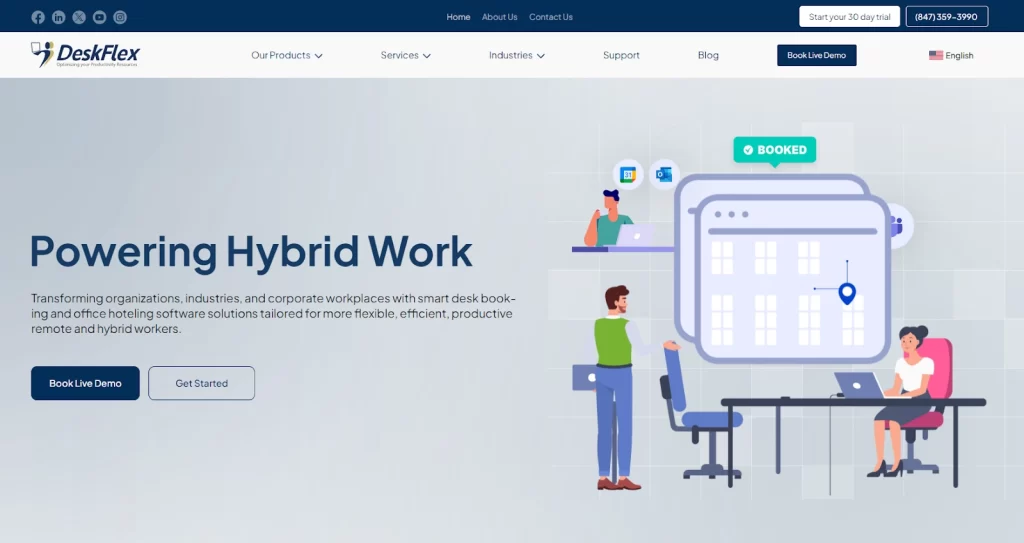
By providing real-time availability updates, 3D floor maps, and hot desking options, DeskFlex supports dynamic space utilization in hybrid environments where flexibility is essential.
Employees can reserve desks and meeting rooms that align with their specific tasks, whether they need a collaborative area or a quiet space for focused work.
Additionally, DeskFlex’s visitor management feature offers insights into space usage patterns, helping companies minimize wasted space and refine their layout planning.
Through these tools, DeskFlex enhances productivity, streamlines workspace transitions, and ensures that office layouts remain adaptable to changing workstyles and business needs.
Ready to enhance your office layout with DeskFlex? Book a Free Live Demo Now.
FAQs About Office Layout
What is the best layout for a co-working office?
The ideal layout for a co-working office balances flexibility with structure. A well-designed co-working space includes flexible layouts that can adapt to different team sizes and projects, with communal seating for open collaboration and networking.
How can office layout improve employee morale and job satisfaction?
An effective office layout can significantly improve morale and job satisfaction by creating a comfortable and productive environment. Key design features like ergonomic furniture, access to natural light, and designated spaces for relaxation contribute to physical comfort and mental well-being.
What is an open-plan office layout, and is it right for all businesses?
An open-plan office layout is a design that minimizes walls and barriers, creating large communal areas where employees share workspaces. While this layout promotes collaboration and allows for more efficient use of space, it may not suit all businesses.
How does a hybrid office layout differ from traditional office layouts?
A hybrid office layout combines elements of both open-plan and traditional office designs, incorporating areas for both collaborative work and individual focus. Unlike traditional layouts, which often have fixed workstations, hybrid layouts feature flexible workspaces, hot desks, and booking systems to accommodate employees who work both remotely and in-office.




































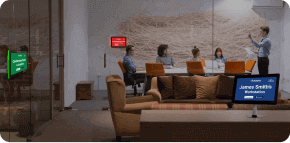










 Support
Support  Demo
Demo  Blog
Blog 